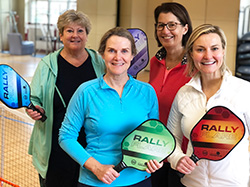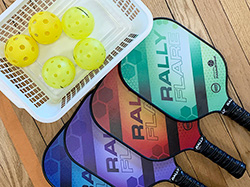WHAT IS PICKLEBALL?
Pickleball is the fastest growing sport in the USA! It is a fun sport that combines many elements of tennis, badminton and ping-pong. It is played both indoors or outdoors on a badminton-sized court and a slightly modified tennis net. It is played with a paddle and a plastic ball with holes.


How to Play
- You can play by yourself or with a teammate. Just like tennis, pickleball has singles and doubles.
- Serves must be underhand.
- You must let the ball bounce before returning the serve.
- You can’t hit the ball in the “kitchen.” The no-volley zone is called the “kitchen,” and it’s 7 feet on both sides of the net.
- Games typically go to 11 points, and you must win by two points.
- Pickleball Open Play is only open to The Connection's Total Facility members.
- Time blocks are ONE hour and reservations should be made at least 24 hours prior to desired time slot. (This includes set up and take-down. Actual play time will be approximately 50 minutes. Please be respectful of classes and other players before after.)
- 2-4 people must be signed up per time slot.
- A Pickleball bag is at the front desk to be "checked out" and returned by the member.
- Members MUST email sangeeta.benbow@theconnectiononline.org or call 908 273-4242 ext.133 to RESERVE a spot. (NO walk ins please) Sangeeta will confirm your time or inform you that there are not enough people to play.
- Open Pickleball days and times are subject to change.
- Pickleball is played either as doubles (two players per team) or singles; doubles is most common
- The same size playing area and rules are used for both singles and doubles
The Serve
- The server’s arm must be moving in an upward arc when the ball is struck.
- Paddle contact with the ball must not be made above the waist level.
- The head of the paddle must not be above the highest part of the wrist at contact.
- A ‘drop serve’ is also permitted in which case none of the elements above apply.
- At the time the ball is struck, the server’s feet may not touch the court or outside the imaginary extension of the sideline or centerline and at least one foot must be behind the baseline on the playing surface or the ground behind the baseline.
- The serve is made diagonally crosscourt and must land within the confines of the opposite diagonal court.
- Only one serve attempt is allowed per server.
- At the beginning of each new game only one partner on the serving team has the opportunity to serve before faulting, after which the service passes to the receiving team.
Scoring
- Points are scored only by the serving team.
- Games are normally played to 11 points, win by 2.
- Tournament games may be to 15 or 21, win by 2.
- When the serving team’s score is even (0, 2, 4, 6, 8, 10) the player who was the first server in the game for that team will be in the right/even court when serving or receiving; when odd (1, 3, 5, 7, 9) that player will be in the left/odd court when serving or receiving.
Two-Bounce Rule
- When the ball is served, the receiving team must let it bounce before returning, and then the serving team must let it bounce before returning, thus two bounces.
- After the ball has bounced once in each team’s court, both teams may either volley the ball (hit the ball before it bounces) or play it off a bounce (ground stroke).
- The two-bounce rule eliminates the serve and volley advantage and extends rallies.
Non-Volley Zone
- The non-volley zone is the court area within 7 feet on both sides of the net.
- Volleying is prohibited within the non-volley zone. This rule prevents players from executing smashes from a position within the zone.
- It is a fault if, when volleying a ball, the player steps on the non-volley zone, including the line and/or when the player’s momentum causes them or anything they are wearing or carrying to touch the non-volley zone including the associated lines.
- It is a fault if, after volleying, a player is carried by momentum into or touches the non-volley zone, even if the volleyed ball is declared dead before this happens.
- A player may legally be in the non-volley zone any time other than when volleying a ball.
- The non-volley zone is commonly referred to as “the kitchen.”
Line Calls
- A ball contacting any part of any line, except the non-volley zone line on a serve, is considered “in.”
- A serve contacting the non-volley zone line is short and a fault.
Faults
- A fault is any action that stops play because of a rule violation.
- A fault by the receiving team results in a point for the serving team.
- A fault by the serving team results in the server’s loss of serve or side out.
Determining Serving Team
- Any fair method can be used to determine which player or team has first choice of side, service, or receive. (Example: Write a 1 or 2 on the back of the score sheet.)
Pickleball Etiquette
- Know your pickleball level. If you do not know, assume you are Level 1. Levels are Beginner 1-2, Intermediate 3 and Advanced 3.5-5.
- Sign up for the appropriate slot (according to your skill level.)
- During “Open Play” sessions, everyone plays with all skill levels. Be patient with those at lower levels.
- You may bring your own racket and balls or use The Connection’s.
- Count the balls to be in play before the game begins.
- Be gentle with all equipment and floors. Treat the court and equipment as if it was yours.
- Begin each game by introducing yourself to each other and saying “hello.”
- Before serving, make sure that the receiver is ready and facing you. Then call the score.
If the ball is out and it’s on your side, call it out. If it’s close, give the benefit to your opponent.
- If you step into the kitchen on a volley, or if your partner does, call it on yourself.
- Never ask for line calls from spectators.
- Never yell or say hostile words to, or behave in a hostile manner towards your opponent.
- Good natured “trash talking” is part of pickle ball, but keep it playful and never refer to anyone’s physical or mental appearance/abilities. Never use slurs or other insensitive words.
- At the end of each game, acknowledge the other team and say goodbye.
- Return the Pickleball bag with 4 rackets and 16 balls to the front desk.
AVAILABILITY
Open play times are available to Total Facility Members with an advanced registration. Check our current In-Person Adult Fitness Schedule for availability.
PRIVATE INSTRUCTION
The Connection is now offering Total Facility Members and Program Members private and semi-private pickleball lessons with Leonard Hutabarat, PPR (Professional Pickleball Registry) Certified Pickleball Coach, USA Pickleball Ambassador.
To inquire about and arrange a day/time for a private or semi-private lesson with Leonard Hutabarat, members can email sangeeta.benbow@theconnectiononline.org. After a lesson day/time is scheduled, they can be purchased at the Member Services desk. Prices below.
| EVENT |
PRICES |
| Clinic |
$15, open to TF members |
| Private Session |
$55/person/hour |
| Semi-Private Session (2-4 students) |
$44/person/hour |


